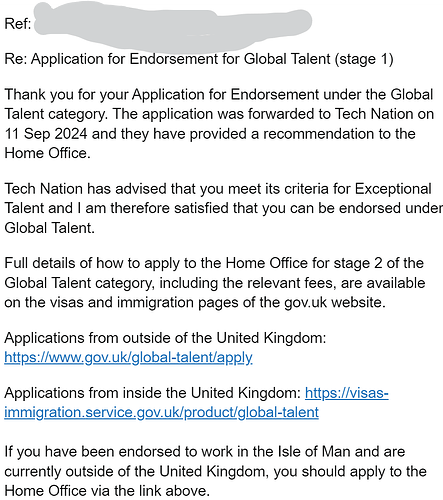Hi all,
I wanted to share my experience and learnings from my recent successful endorsement for the “Exceptional Talent” visa. This forum helped me understand others’ experiences, common mistakes, and more, so I hope my journey can help others as well.
I applied as an expert in AI/ML and submitted the following documents:
Letters of Recommendation (LOR):
- LOR 1: From the head of my practice at my current employer.
- LOR 2: From the CEO of my previous company.
- LOR 3: From the founder of a build-tech company where I volunteered as a Tech Advisor.
Leadership Category:
- MC 1: A letter from the CEO of a part-time company where I worked as CTO until it closed in 2021.
- MC 2: Product snapshots of the solutions I developed at my current company, along with workflow diagrams and their impact.
- MC 3: Proof of my salary (in the early six figures) with a comparison to similar roles on Glassdoor, supporting the evidence in MC 2.
- MC 4: An offer letter from a venture program (fast-tracked by Tech Nation).
Innovation Category:
- OC 1.1: A product I developed for the company where I was the part-time CTO.
- OC 1.2: Another product from the same company.
- OC 1.3: QuickBooks snapshots showing the company’s revenue (£600,000 over 3 years), my benefits, and documents related to the company’s LLC and dissolution. This supported OC 1.1 and OC 1.2.
Impact Category:
- OC 3.1: My role as a Tech Advisor at a build-tech company, where I highlighted the products I developed and their impact (the company receives 400,000+ visitors yearly). LOR 3 supported this evidence.
- OC 3.2: Products I developed at my previous company and their impact.
- OC 3.3: My salary document, supporting OC 3.2.
I completed this application entirely by myself. Even though I initially considered hiring help, I realized that no one knows your work better than you. In the end, it took me about 50-60 hours to complete the entire application.
One key takeaway: even though “Impact” has a separate section, I showed impact (in terms of numbers, quality, and quantity) in every document, from the statement of purpose to LORs and evidence. Numbers matter a lot, and that’s what they focus on. I felt confident about my application, knowing that only a very strong reason could lead to rejection.
I also included my venture program offer letter, even though most people advised against it. However, I made sure it fit well into my story. I weaved everything—statement of purpose, letters, and evidence—together into a cohesive narrative, ensuring it was strong and logical.
It’s important to support each piece of evidence with other documents. For example, if I submitted OC 1.1 and OC 1.2 about the products I developed as CTO, I also included financial records (OC 1.3) to show the revenue those products generated. This was further backed by a letter (MC 1). Making your case watertight is crucial.
For the evidence itself, ensure your documents are clear and well-organised. Use proper formatting, add subheadings for each snapshot, and highlight key information using different colors. To fit more information in your documents, reduce side margins and use small but clear snapshots (I used 300 pixels). Also, make sure to write in UK English and avoid spelling or grammar mistakes.
Writing reports for various programs helped me a lot in this process, but remember—everyone’s approach is different. As long as your work is solid and your information is clear, you should be in a good position.
I received my decision in just 5 days with 7 edits I could count.
I hope this helps, and best of luck to you!
